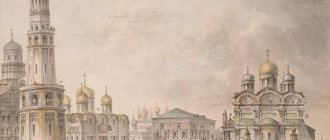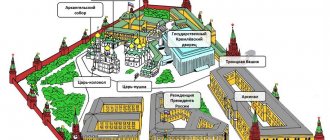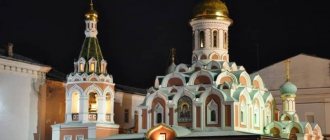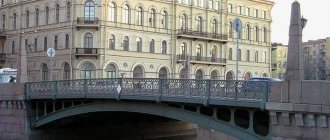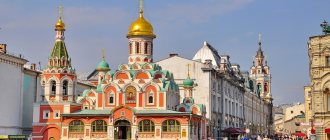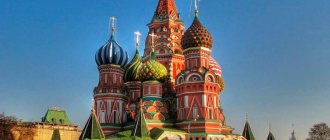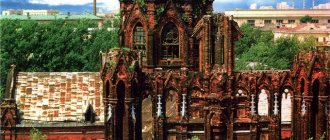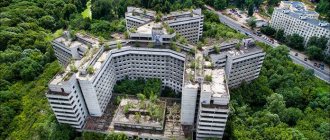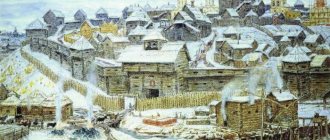The Annunciation Cathedral in Moscow is an Orthodox church built in honor of the Annunciation of the Virgin Mary and bearing her name. It is located on Cathedral Square in the Moscow Kremlin complex. Next to it, the ensemble of Cathedral Square includes the Archangel Cathedral, the Assumption Cathedral and the Church of the Deposition of the Robe.
The founding date of the cathedral is considered to be 1489, when, by order of Ivan III, Pskov architects created a white-stone cathedral on the basement of an old temple that stood on this site in the 14th and early 15th centuries. Shortly after construction, the three-domed cathedral was noticeably damaged during a fire in 1547, but was restored in 1564. From that moment on, he became nine-headed, which symbolizes the Heavenly Church, which has nine ranks of Angels and the Righteous of Heaven.
The interior of the cathedral includes unique ancient frescoes and icons from the 14th–15th centuries, relics and archaeological treasures that are available to visitors.
Unlike other large cathedrals in the Kremlin and Moscow, the Annunciation Cathedral is modest in size and was intended for visiting the royal family and princes. Baptismal ceremonies and weddings of crowned heads were performed there. Until the 18th century, the Annunciation Cathedral was the home church of the Russian tsars and their entourage, and its priests were the confessors of royalty.
After the Revolution of 1917, the Annunciation Cathedral was closed and resumed its work in 1993. Currently, it is one of the main attractions of the Kremlin and all of Moscow.
© Julia Alisova
Story
Built under the Grand Duke, Sovereign of “All Rus'” Ivan III in 1484–1489, the Annunciation Cathedral has a special significance in the history of Russian architecture, since most of the buildings of the new Grand Duke’s residence of Ivan III were erected by Italian architects; the cathedral became an outstanding monument of the Russian architectural tradition. According to the chronicle, it was created by Pskov craftsmen. In the appearance of the cathedral, the features of Moscow architecture were combined with details characteristic of Pskov architecture. It is decorated with the favorite decorative semicircular niches in Pskov architecture and the “runner” and “curb” belts made of specially shaped brick. At the same time, we see tiers of keel-shaped zakomars and kokoshniks, characteristic of Moscow architecture. The cathedral is elegant and small, which fully corresponded to its role as the home temple of the grand ducal family.
K.-F. Beaudry. Procession of the cross at the Annunciation Cathedral in the Moscow Kremlin. 1860
Upon completion of construction in 1489, the cathedral was consecrated in honor of the Feast of the Annunciation (April 7), established in memory of the Good News of the birth of Jesus Christ, brought by the Archangel Gabriel to the Virgin Mary.
In 1508, by order of Grand Duke Vasily Ivanovich, the “top of the church” was gilded, the icons of the iconostasis were “overlaid with silver and gold and beads,” and the son of the famous artist Dionysius, Theodosius, signed the church with “gold.” In 1520, the cathedral porches were decorated with paintings.
Initially, the Annunciation Cathedral had three domes and was surrounded on four sides by porch galleries. In the 1560s, by order of Tsar Ivan IV the Terrible, 4 small side-altar churches were built at the corners of the galleries, and two blind domes were erected above the western part of the cathedral. The domes and roof were covered with gilded copper sheets. It was at this time that the picturesque appearance of the nine-domed cathedral that we see today was mainly formed.
Researchers associate this stage of construction and the dedication of the chapels with the major events of the mid-16th century: the crowning of Ivan the Terrible, the conquest of Kazan, one of the victories of the Livonian War - the capture of Polotsk. Obviously, by rebuilding and decorating his home church, Ivan the Terrible sought to strengthen its role in the Kremlin ensemble, to make the temple worthy of an autocratic ruler of a huge state.
The Annunciation Cathedral was the home church of Russian great princes and tsars for centuries; in documents of the 16th–17th centuries it was called “the temple in the sovereign’s courtyard”, “in the entryway”, “at the passages”, because The temple building was part of the complex of the grand duke and then the royal palace, which consisted of separate chambers. Since ancient times, sacred relics have been kept in the cathedral: relics, especially revered icons, ancient books, precious vessels. The rector of the Annunciation Cathedral was traditionally the tsar's confessor.
After the 1917 revolution, the cathedral was closed. In 1918, museums were organized in the Kremlin, and all further activities were aimed at studying, restoring and preserving the cathedral and the works of art stored in it.
In 1989, the Annunciation Cathedral celebrated its 500th anniversary. An exhibition of icons and church items related to the history of the cathedral was opened in the southern gallery.
Since 1993, services on the patronal feast of the Annunciation, which are performed by the Patriarch of Moscow and All Rus', have been resumed in the cathedral.
What is the Kremlin?
Before we look at the external and internal decoration of the Annunciation Cathedral, let's understand what the Kremlin is? This is a detail of urban planning characteristic of the so-called German type. Once upon a time, the ancient Slavs completely fenced their settlements. And it was called “fortification”, “kremlin”. In the Ukrainian language, as a more archaic language, the word “vіdokremlyuvati” has been preserved. It means “to separate”, “to enclose”.
The Norman princes introduced their customs into the urban planning of the ancient Russians. The rulers' house stood apart from other dwellings and was fenced off from the "posad" by a wall. This fortress in the city still bore the name of the Kremlin. Residents were forced out of the fence and settled without defensive walls. According to German law, the lord of the castle had to provide shelter to his vassals in the event of an enemy attack. But this is not the case with the Moscow princes. They regarded their fortress as a private residence. And they decorated it accordingly.
This is how the Kremlin cathedrals appeared. The Annunciation Cathedral served as a house church, and the Arkhangelsk Cathedral served as a tomb for members of the royal family. Ordinary Muscovites listened to services in parish churches in Posads. And all the luxury of the interior decoration of the Kremlin churches was given only to a select few, close to the throne.
Description
The Annunciation Cathedral was built by Russian craftsmen in the traditions of Pskov and Moscow architecture on the old basement, preserved from the previous temple. The modern appearance of the cathedral with covered galleries and four chapels at their corners, with a pyramidal silhouette topped with nine gilded domes, took shape in the 60s of the 16th century.
The walls of the cathedral are dissected by blades and finished with keel-shaped zakomars, which is typical of early Moscow architecture; the rhythm of the zakomars is repeated by the kokoshniks at the base of the central chapter; narrow slit-like windows are inscribed in the arched frieze.
The eastern wall was originally covered by a gallery, so only a modest belt of balusters was placed high on the apses. At first it was terracotta, as in the Church of the Deposition of the Robe, built simultaneously with the Annunciation Cathedral and by the same masters, but in the 19th century it was replaced with stone.
The chapels, added in the 1560s, successfully complement the main volume: their walls are divided by square flies and completed with small kokoshniks echoing the cathedral's zakomaras. The construction of chapels in the Annunciation Cathedral in 1564-1566 fundamentally changed the artistic appearance of the monument and made it sound new in the ensemble of Cathedral Square. The Annunciation Cathedral has four chapels - small single-domed pillarless churches with thin walls one brick thick. They are erected above the corners of the galleries. Researchers associate the creation of the chapels with the major events of the Grozny period in the mid-16th century - the crowning of Ivan the Terrible, the capture of Kazan, the capture of Polotsk in 1563 (one of the victories in the Livonian War).
Well-preserved interiors of the chapels with carved white stone floors and complexes of iconostases from the 60s of the 16th century make it possible to restore the interiors of these interesting cultural monuments of Rus' from the time of Ivan the Terrible.
By surrounding the central volume of the building with small separate chapels-churches, the architects of the mid-16th century fundamentally changed the original ideological and artistic concept of the monument. Having lost the slender silhouette and harmonious balance of the interior and exterior of a small Moscow church at the end of the 15th century, the Annunciation Cathedral acquired the picturesque splendor characteristic of architectural monuments of the Grozny era, and became a kind of monument representing the Grand Duke’s house on Cathedral Square, emphasizing the significance of the new position of the Moscow sovereign - “tsar” of all Rus'." The nine-domed pyramidal composition brings the Annunciation Cathedral closer to the monument to the Kazan victory - the Intercession Cathedral on Red Square.
The cathedral building stands on a high basement. The basement is an architectural monument of the late 14th century. This is a square room under the central part of the cathedral, made of large white stone blocks. In the center is a massive pillar with low arches spanning from it to the walls. An apse adjoins it from the east. Probably, initially the grand ducal treasury was kept in the basement. Since 1989, an archaeological exhibition has been opened there, the exhibits of which are related to the history of the settlement and development of Borovitsky Hill, with unique treasures that were found in the 19th – 20th centuries. on the territory of the Kremlin.
The cathedral is surrounded on three sides by galleries. The architecture of the northern and western front galleries clearly shows features of the Italian Renaissance. They are covered with beautifully contoured cross vaults, the pillars supporting them are decorated with panels and crowned with carved white stone capitals; similar capitals also decorate the blades of the walls. The northern and western galleries were used in ceremonial processions, for the passage of royal processions, and for the Tsar's Orthodox guests to receive the Palace of Facets.
The southern and now lost eastern galleries were erected simultaneously in 1489. The southern porch was already a separate closed room. Probably in the middle of the 16th century. the chapel of Basil of Caesarea was moved here from the deaconry. In 1562-1564, the chapel located in the gallery was updated.
The southern and eastern galleries connected the temple with the palace and the Treasury Chamber, where the prince’s property was kept. The construction of the porch from the east, on the side facing the square, was unusual for Russian architecture: nothing was supposed to be attached to the altars. Subsequently, the eastern gallery was dismantled along with the adjacent treasury chambers. The kings walked along the southern porch from Cathedral Square to their palace, connected by passages with the house church. The entrance to the cathedral from the walkway is decorated with a portal typical of Moscow architecture of the 15th century.
Interior decoration
The southern porch has almost completely lost its original appearance: the vaults have been rebuilt, the western and eastern walls have been rebuilt, and the blades of the cathedral quadrangle have been hewn. The biggest changes date back to 1836, when a chapel of St. Nicholas the Wonderworker, patron of Emperor Nicholas I, was built in the gallery. Later it was used as a workshop for embroiderers, and the cathedral sacristy was located here. At this time, the portal and shoulder blades of the quadrangle were sheared off. The portal was restored in 1949. It is made in the traditions of early Moscow architecture - perspective in shape, with alternating rectangular projections and semi-columns with beads at half the height and sheaf-shaped capitals. The portal ends with a keel-shaped arch.
A porch decorated with carvings leads to this porch (from the Moskva River). In the 1550-1560s, the south porch, previously open, was made closed.
The southern porch of the temple overlooked a small palace garden, along which one passed to the Archangel Cathedral; it served as a place for rest and distribution of alms. A white stone carved portal, a window frame and part of a frieze on the wall dating back to the mid-15th century have survived to this day.
Until the 19th century, the southern porch probably did not have continuous painting, but was decorated with carvings. The richness and sophistication of the decor are evidenced by the preserved carved details - the window casing in the eastern part and the column of the mid-15th century, discovered during the restoration in 1949. Its trunk and capital are covered with a soft planar pattern of large acanthus leaves, painted with yellow, light green and red paints. Traces of multicolor painting were also found on the carved details of the south porch. The columns at the entrance to the porch were opened during the restoration of the 1860s and then replaced with crude copies.
Purpose
The Grand Dukes, and then all the Russian Tsars, used the Kremlin's Annunciation Cathedral as a local church. All family sacraments (baptism, wedding) were performed in it. The rector of the cathedral became the confessor of the ruler of Rus', he confessed him, helped to draw up and certified his will, and in long conversations could give advice to the tsar. The Annunciation Church housed the valuables of the princely (royal) family (relics, icons, relics of saints). The first Moscow princes kept their treasury in it. Each successive representative of the dynasty, having ascended the throne, tried to improve the decoration of the cathedral, add something of their own to its appearance, and leave a reminder of themselves to their descendants.
Patronal holidays
Annunciation of the Blessed Virgin Mary
— April 7
Gabriel, Archangel
— November 21, July 8, July 26
Cathedral of the Blessed Virgin Mary - January 8
Entry of the Lord into Jerusalem
— Sunday before Easter
Alexander Nevsky, noble prince
- December 6
Nicholas the Wonderworker, Archbishop of Myra, Saint
— May 22, December 19
Shrines of the Annunciation Cathedral
In the Annunciation Cathedral of the Moscow Kremlin there were, as in a precious casket, many Orthodox shrines: miraculous and revered icons of the Mother of God and the Savior.
Fragment of the icon of the Mother of God from the iconostasis of the Annunciation Cathedral Fragment of the icon of the Savior from the iconostasis of the Annunciation Cathedral
One of the cathedral’s shrines was the “Donskaya” icon of the Most Holy Theotokos, which was with Prince Dmitry Donskoy on the Kulikovo field during the battle. St. Sergius of Radonezh blessed Dmitry Donskoy with this icon before the battle. In the 17th century, the Donskoy Monastery was built in the name of this miraculous icon.
Don icon
The Annunciation Cathedral survived all the troubles that our Mother Russia experienced. And fires, and enemy invasions, and devastation from foreign invaders, and devastation from our own atheists.
Pilgrim
The architectural ensemble is open to the public from 10:00 to 17:00.
From May 15 to September 30 from 9:30 to 18:00.
Day off is Thursday.
A single ticket for visiting the architectural ensemble of Cathedral Square gives the right to view the Assumption, Archangel, and Annunciation Cathedrals, the Church of the Deposition of the Robe, the Patriarchal Chambers with the Church of the Twelve Apostles, the exhibition “Treasures and Antiquities of the Moscow Kremlin” in the basement of the Annunciation Cathedral, and the exhibition of Russian wooden sculpture in the covered gallery of the church Placing the Robe, an exhibition dedicated to the Ascension Monastery in the southern annex of the Archangel Cathedral.
Ticket price (without discounts) - 500 rubles.
The ticket price for Russian full-time students and pensioners (upon presentation of the relevant documents) is 250 rubles.
The architectural ensemble and exhibitions are free to visit:
Persons under 16 years of age, regardless of citizenship; members of large families; persons receiving a survivor's pension; disabled people of groups I and II; children with childhood disabilities; children under the care of the state (orphans); WWII participants and equivalent categories; museum staff (RF and CIS); clergy (Russian Federation and CIS); members of the Society of Friends of the Museum; conscripts. Persons under 18 years of age - every second Tuesday of the calendar month.
Tickets can be purchased:
— Online on the museum’s website, except for discounted and free ones;
— at the box office in the Alexander Garden from 9:30 to 16:30.
From May 15 to September 30 from 9:00 to 16:30. Day off is Thursday.
Additional services:
— excursions accompanied by a museum guide.
Amateur photography and video shooting in cathedral museums is prohibited.
Attention! A visit to the Armory Chamber requires a separate ticket.
Decor
The execution of canonical paintings and icons could not be entrusted to non-believers. But the design of the interior decoration could be entrusted to Italian craftsmen, fashionable at that time. Carvers from Lombardy and Tuscany decorated the white stone portals with dolphins, flowers, fruits and lamps. This decor is typical of High Renaissance art.
At the beginning of the sixteenth century, the portals of the Annunciation Cathedral were decorated with double-leaf copper gates. Their doors are covered with images of the prophetesses Sibylla, sages and prophets. The technique itself is interesting. This is a gold tip using amalgam.
It should also be mentioned that it was from the palace Church of the Annunciation that Muscovites first began to recognize the time. The monk from Athos Lazar Serbin installed masses with a wooden human figure. She beat the time by striking the bell around the clock. This was back in the fourteenth century. And in 1624, the English master Christopher Galovey installed the main chimes of Russia on the Spasskaya Tower of the Kremlin. The museum, which now operates in the temple, stores frescoes by Andrei Rublev. You should also pay attention to the painting “Rejoices in You” from the sixteenth century.
painting
The most ancient authentic examples of frescoes were lost during fires and reconstruction of the cathedral. Modern paintings are their copies; they were made by artists of the 16th century, who tried to convey the colors, shapes and meaning of the plots. Surprising is the fact that, along with traditional biblical motifs, the faces of Russian princes and ancient philosophers are depicted on the walls, vaults, columns, this gives uniqueness to such a monument as the Annunciation Cathedral of the Kremlin. Moscow, Russia does not have more ancient examples of temple painting. This museum houses works of religious art that have no analogues. The image of the Annunciation belongs to the most ancient and rare type of iconography.
Ivan groznyj
In 1547, Moscow and the Kremlin buildings were significantly damaged by a large fire. The Annunciation Cathedral was no exception, so Ivan the Terrible ordered it to be completely restored (in fact, built). In 1564, the temple was erected, painted, decorated more richly than under his father (Basily III), and illuminated. The porch was decorated with carved white stone portals made by Italian craftsmen. Copper doors decorated with gold became unique for that time. The iconostasis and painting of the vault, walls and columns of the temple were partially recreated. By order of Ivan the Terrible, a porch (Grozny) was added to the Annunciation Cathedral; according to legend, it was the place where the tsar saw the harbinger of his death.
